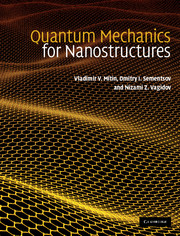Book contents
- Frontmatter
- Contents
- Preface
- List of notation
- 1 The nanoworld and quantum physics
- 2 Wave–particle duality and its manifestation in radiation and particle behavior
- 3 Layered nanostructures as the simplest systems to study electron behavior in a one-dimensional potential
- 4 Additional examples of quantized motion
- 5 Approximate methods of finding quantum states
- 6 Quantum states in atoms and molecules
- 7 Quantization in nanostructures
- 8 Nanostructures and their applications
- Appendix A Classical dynamics of particles and waves
- Appendix B Electromagnetic fields and waves
- Appendix C Crystals as atomic lattices
- Appendix D Tables of units
- Index
Preface
Published online by Cambridge University Press: 05 June 2012
- Frontmatter
- Contents
- Preface
- List of notation
- 1 The nanoworld and quantum physics
- 2 Wave–particle duality and its manifestation in radiation and particle behavior
- 3 Layered nanostructures as the simplest systems to study electron behavior in a one-dimensional potential
- 4 Additional examples of quantized motion
- 5 Approximate methods of finding quantum states
- 6 Quantum states in atoms and molecules
- 7 Quantization in nanostructures
- 8 Nanostructures and their applications
- Appendix A Classical dynamics of particles and waves
- Appendix B Electromagnetic fields and waves
- Appendix C Crystals as atomic lattices
- Appendix D Tables of units
- Index
Summary
Nanoelectronics is a field of fundamental and applied science, which is rapidly progressing as a natural development of microelectronics towards nanoscale electronics. The modern technical possibilities of science have reached such a level that it is possible to manipulate single molecules, atoms, and even electrons. These objects are the building blocks of nanoelectronics, which deals with the processes taking place in regions of size comparable to atomic dimensions. However, the physical laws which govern electron behavior in nanoobjects significantly differ from the laws of classical physics which define the operation of a large number of complex electronic devices, such as, for example, cathoderay tubes and accelerators of charged particles. The laws that govern electron behavior in nanoobjects, being of quantum-mechanical origin, very often seem to be very strange from a common-sense viewpoint. The quantum-mechanical description of electron (or other microparticle) behavior is based on the idea of the wave–particle duality of matter. The wave properties of the electron, which play a significant role in its motion in small regions, require a new approach in the description of the electron's dynamic state on the nanoscale. Quantum mechanics has developed a fundamentally new probabilistic method of description of particle motion taking into account its wave properties. This type of description is based on the notion of a wavefunction, which is not always compatible with the notion of a particle's trajectory. This makes electron behavior harder to understand.
- Type
- Chapter
- Information
- Quantum Mechanics for Nanostructures , pp. ix - xiiPublisher: Cambridge University PressPrint publication year: 2010

